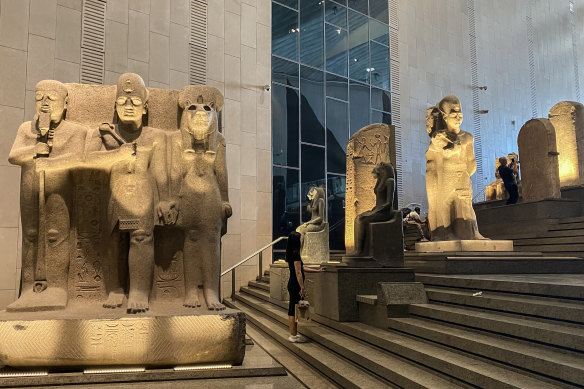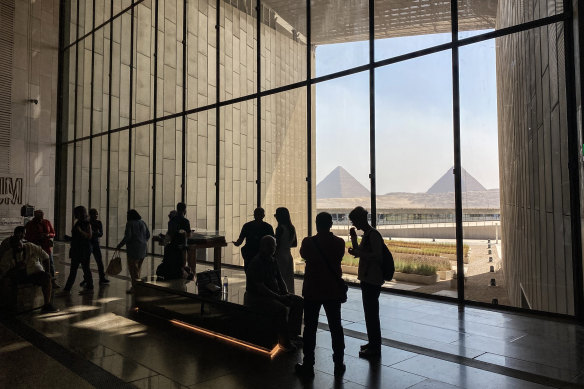
Anyone who has wandered its gloomy rooms and peered into its dusty display cases will know that it is a relic of the Victorian era – constructed in 1901, and barely changed in the 123 years that have followed.
Crowded and chaotic, it falls short of the standards required for a major archaeological museum in the 21st century. Egypt has long needed a state-of-the-art facility to focus a spotlight on its remarkable heritage. Now, at last, it seems to have one.

The new Grand Egyptian Museum arrives 11 years behind schedule.Credit: Getty Images
The basic numbers behind the GEM are also remarkable. The cost of its construction is estimated at a weighty $US1 billion ($A1.51 billion). It is the world’s largest archaeological museum, with a total floor space of 490,000 square metres. Once it is fully operational, it will be able to hold more than 100,000 items, including the complete collection of artefacts discovered in the tomb of the boy-pharaoh Tutankhamun. This alone amounts to 5500 treasures – many of which have been languishing in storage.
Unlike its fabled but flawed predecessor on Tahrir Square, the museum is not in Cairo. It sits about 16 kilometres to the south-west, on the opposite bank of the Nile, in Giza. And if the difference between the Egyptian capital and the neighbouring city with which it shares a conurbation is not always obvious (although the river is a pretty big clue), one particular set of landmarks offers clear indication that you have crossed into the latter.
The GEM stands less than two kilometres from the Pyramids, and is designed to go hand-in-hand with the ancient world’s foremost set of tombs. The opening of a new airport in Giza – the aptly named Sphinx International – at the start of 2020 has also polished the idea of an extensive development of considerable importance, to which the planet is meant to flock.

The new museum is a short distance from the Pyramids, with the two designed to be visited hand-in-hand.Credit: Getty Images
So why has it taken so long to cut the ribbon? This is a question that has baffled many, and comes with no catch-all answer. True, Egypt has undergone regime change in the 22 years since work began, but the laying of that foundation stone is so far back in the past that the man who placed it, the dictator Hosni Mubarak, has now been out of power for 13 years, and dead for four.
The revolution which deposed him in 2011 – part of the briefly optimistic Arab Spring demonstrations which curdled into something far darker (to the extent that the original Egyptian Museum was reputedly used for the torture of dissidents) – undoubtedly contributed to the delay, but is now also more than a decade into yesteryear. There have been financial pinch-points, but the money – including a $US300 million loan from the Japan Bank for International Cooperation – has generally been there. There was a fire at the museum entrance in April 2018, but this proved to be a relatively minor incident, which did not have a serious impact on progress.
The pandemic was a further factor – although I remain confused as to why it should have been. I was one of the first journalists to tour the site, being allowed into its laboratories (where conservation work on various Tutankhamun artefacts was ongoing) – and into the colossal entry hall, where the 11-metre, 83-tonne, 3200-year-old statue of the formidable pharaoh Ramesses II, which has been the GEM’s postcard image to date, was already in position.
My visit was in April 2019 – when COVID was still little more than a sore throat in a wet-market. At the time, I couldn’t have conceived that the museum’s opening would be more than five years away – even with the two-year hand-brake of a global health crisis. To my (admittedly untrained) eye, it seemed all but ready. I was not told otherwise.
Loading
Still, 2019 has become 2024, tomorrow looks to have become today, and the Grand Egyptian Museum appears set – after so much waiting – to fulfil the promise of its name.
Of course, there have been false-starts before. April 3 2021 saw Egypt break from the grim mundanity of the pandemic to stage what was emphatically termed the “Pharaohs’ Golden Parade”.
This was the lavish transferral of 22 pharaonic mummies (18 kings, four queens) to a new palatial des-res. While their destination was not the GEM, but another fresh archaeological institution – the National Museum of Civilisation (NMEC), in the Old Cairo district of Fustat – the ceremony seemed to declare the end of an era.
Here, finally, it seemed, was the pensioning off of the Egyptian Museum, its retirement marked by the removal of its star residents from their distinctly dingy resting place (an underlit antechamber; surcharge to the main ticket; cash only).
Loading
These journeys came with plenty of pomp and no little circumstance, the former monarchs being conveyed across town in quasi-chariots as spotlights swirled and soldiers marched; a bright spectacle broadcast live on Egyptian television. But while the NMEC officially turned its lights on that same evening, the GEM skulked in darkness for another three years. The reasons remain vague.
One of the rulers moved that day was Ramesses II himself; that titan of the 19th Dynasty, who is believed to have reigned in Egypt between 1279 and 1213 BC. But while his mummy now has visitors at the NMEC, his totemic statue at the GEM – which was unearthed at the Great Temple of Ptah, near the ruins of the ancient city of Memphis, in 1820 – will only, finally, greet onlookers now.
The road to the opening of the Grand Egyptian Museum has been so potholed and meandering that even the supposed “Pharaoh of the Book of Exodus” – Moses’s irate biblical nemesis – has been left discombobulated.



























